
* At the outset, Darwin knew his theory needed more work and data, and was gratified to see that new fossil discoveries did much to buttress his ideas. However, he clearly recognized the weakness of contemporary knowledge of the mechanisms of heredity. He would never know that an Austrian monk named Gregor Johann Mendel had taken the first big steps towards resolving that difficulty not long after the publication of THE ORIGIN OF SPECIES. Along with the failure to understand the mechanisms of heredity, the development of evolutionary theory in the late 19th century was hobbled by disputes over mechanisms and uncertainty over the age of the Earth -- as well as attempts to apply evolutionary theory to human society in ways that later generations would see as entirely misguided.
* Thomas Huxley was not merely an aggressive bulldog in his fight against Darwin's enemies; he was also careful to make a persuasive case for Darwin's ideas. He published EVIDENCE AS TO MAN'S PLACE IN NATURE in 1863 to point out the clear physical relationships of the structures of men and apes, with the book providing a famous -- or infamous, depending on one's point of view -- illustration: the skeletons of the known apes, carefully arranged to hint at a progression to the skeleton of a man.
In proclaiming the downfall of the wall between humans and animals, however, Huxley was careful to point out that did not mean the fall of all morality as well, that a description of the nature of human beings said little about what was right or what was wrong. Did the natural origins of humans, he asked, make the strivings of a philanthropist or a saint futile? On the other side of the coin, was "mother-love vile because a hen shows it, or fidelity base because dogs possess it?" He was far-sighted in making the distinction, since even in the 21st century, creationists hysterically insist that evolutionary theory justified a rejection of traditional ethics, labeling it an anti-ethical doctrine.

Sir Charles Lyell also bolstered the case, at least to an extent, by publishing a book titled ANTIQUITY OF MAN in the same year, 1863. It made a case that humans had been around since well before the beginning of recorded history. The evidence was fairly slight at the time, but remains had been found of ancient humans, their flint and bone tools, and their settlements, partly dated by the butchered remains of long-extinct animals that they preyed on. One particularly interesting find had been the discovery in Germany in 1856 of remains of people who were clearly human, but whose features were clearly distinct from those of modern humans. They were named "Neanderthals", after the locale of their discovery.
Lyell's book was popular, but Darwin was upset that it did not endorse natural selection. Lyell conceded the evolution of humankind to an extent, but didn't feel that natural selection could account for human intellect. Lyell defended himself in a letter to Darwin: "I have spoken out to the utmost extent of my tether, so far as my reason goes, and farther than my imagination and sentiment can follow." In hindsight, Darwin was being, as his custom, fussy: ANTIQUITY OF MAN was not all that hostile to Darwin's concepts, and because of Lyell's authority and good writing skills, did much to bolster evolutionary ideas.
Huxley was more committed to the cause, further building up the brief for evolutionary science by helping bring to light new data in the fossil record. In 1861, workers at a limestone quarry at Solnhofen in Bavaria found a fossil of what looked like a reptile, except that the fossil included a distinct outline of feathers: it was clearly a bird. It was given the name Archaeopteryx. A small dinosaur named Compsognathus was found at the quarry as well, and in 1868 Huxley published a paper describing the two as demonstrating elements in a bridge from reptiles to birds.

The Archaeopteryx fossil didn't have a head, but Huxley suggested that the beast actually had teeth. In 1872, the American paleontologist O.C. Marsh (1831:1899) found two more toothed birds from a later era, Ichthyornis dispar and Hesperornis regalis from later strata, suggesting Huxley was on the right track -- which was proven in 1877, when a second Archaeopteryx fossil was discovered at Solnhofen that did have a head.
An important "intermediate form" had been discovered. Not only did Archaeopteryx have teeth, it also had claws on its wings -- fully articulated hand structures, not the simplified structures found on the wings of a few modern birds -- and its breastbone was undeveloped compared to that of modern birds, meaning its chest musculature was also undeveloped and that it likely wasn't capable of any more than occasional dashes into the air, like a flying fish. At least six Archaeopteryx fossils are known to our time, a fairly good sample but one that illustrates just how rare fossils are. Older birds have been found since its discovery, including a 21st-century find of a proto-bird that had both front wings and small wings on its rear legs. The significance of Archaeopteryx for evolution is so great that some creationists still insist the fossils are frauds, but the fossils have been tested using modern mineralogical analysis techniques and have been validated beyond any sensible challenge.
Huxley was only getting started. In the late 1850s, a French paleontologist named Jean Albert Gaudry (1827:1908) had discovered a fossil of an ancient three-toed horse in Greece. Researchers suspected that it was a link to a five-toed ancestor, and in the early 1870s, Huxley and a Russian paleontologist named Vladimir Kovalesky had managed to construct a rough evolutionary tree of horses. O.C. Marsh then went on to find four-toed and five-toed horses in fossil beds in the United States. Huxley wrote Marsh to register sheer joy at the finds, and Marsh replied that the evolutionary trees of birds and horses would lead "the doubting brother" across the gap to accept evolution. Incidentally, while modern horses have much-reduced vestigial side toes known as "splints", rare "throwback" or "atavistic" horses with three side toes have been recorded from antiquity, bolstering the case for horse evolution.
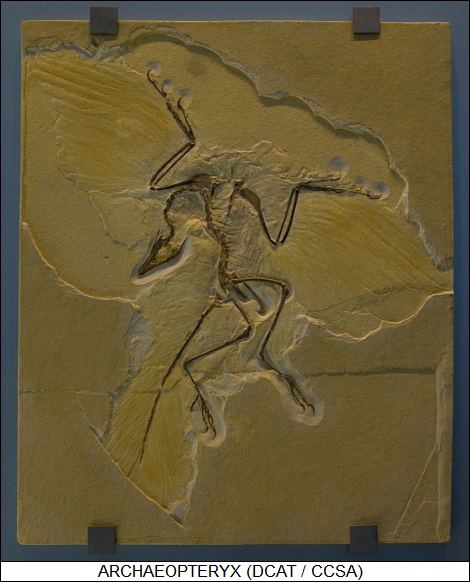
In fact the bird and horse trees remain classic evidence for evolutionary theory, though to no surprise they have been enhanced over a century and a half, revealing more complicated evolutionary trees, more heavily laden with branches than once thought. Incidentally, it has become common in modern times to find out that evolutionary sequences appear increasingly complicated over time, but this does not create difficulties for evolutionary theory: the older notions were not discredited because they went too far, it was because they didn't go far enough.
* Darwin, in his methodical fashion, was not quick to push the limits of his ideas, and in fact for a decade after the publication of THE ORIGIN OF SPECIES, he focused on specialized works for naturalists, one of the more interesting being FERTILIZATION OF ORCHIDS, published in 1862. Like his work on barnacles, his study of orchids provided more resources for his ideas on natural selection: orchids feature a wide range of elaborate mechanisms for ensuring that pollinators visiting the flower get their fair share of pollen, but remarkably these mechanisms were all clearly modifications of the ordinary parts of flowers.
Darwin finally took on the issue of human origins in THE DESCENT OF MAN, published in 1871, following it up with THE EXPRESSIONS OF EMOTIONS IN MAN AND ANIMALS in 1872. Neither book had the impact of THE ORIGIN OF SPECIES. As far as DESCENT OF MAN went, there wasn't much fossil evidence available in the 1870s on human ancestry, and all Darwin could do was cast about for other justifications in the evidence, mostly in terms of the similarities of humans with other animals. He did so thoroughly, leaning heavily on his earlier ideas for sexual selection, but in an overstuffed fashion that had a diffuse impact compared to the focused argument of THE ORIGIN OF SPECIES.
EXPRESSIONS OF EMOTIONS was even less substantial, an obsessive examination of emotional expression in animals and humans -- spending pages, for example, discussing shrugs or other gestures -- and did not do much more than expand on the case that he made in DESCENT OF MAN that emotions were not unique to the human species and had their roots in the dictates of natural selection -- as did the human sense of morals. It paved the way for later evolutionary studies of behavior. The two books provoked even greater disgust from disbelievers, and Darwin's brief remained controversial.
Darwin shrugged and went back to producing specialized works for naturalists, one of the more interesting being INSECTIVOROUS PLANTS, published in 1875. It was another interesting set of case studies for evolutionary science. Such plants live in boggy areas where there is little nitrogen in the soil and so obtain it from the bodies of insects, but use a variety of tactics to catch them. Venus flytraps imprison them between jawlike pairs of leaves; sundews catch them with stalky heads covered with gluey hairs; and pitcher plants drown them in little basins, lined with slick or bristly sides to make escape difficult.
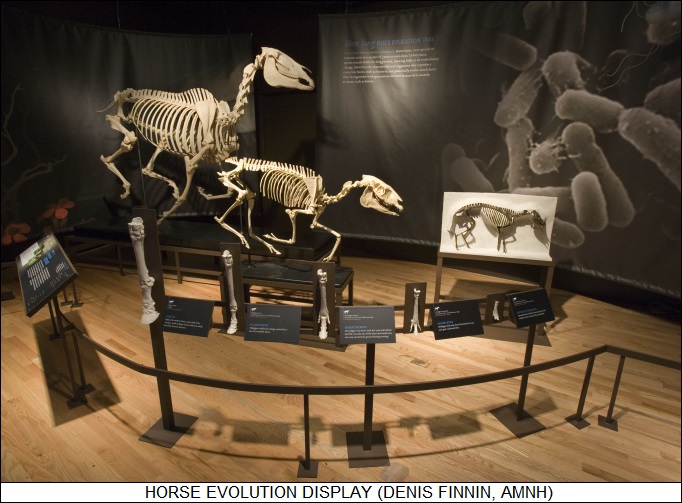
Darwin never published another major work up to his death of heart failure in 1882. He had planned to be buried in Down -- but such was his notoriety that his body was grabbed by the authorities to be buried in Westminster Abbey. The pallbearers included Hooker, Huxley, and Wallace.
BACK_TO_TOP* Darwin's influence on the future development of the biological sciences is hard to overstate. Before him, biology was an assortment of various studies, some that were not much more than "stamp collecting" -- but his concept of evolution, backed up for the first time by a realistic mechanism, demonstrated that all facets of biology were part of a common fundamental theme. Darwin had, in effect, developed a "grand unified theory" of biology.
However, his enormous influence would eventually turn out to have a downside. Although the use of the term "Darwinism" as a synonym for modern evolutionary theory (MET) was common in scientific literature in the 20th century, particularly in Britain, in the 21st century there is a growing realization that was unwise. It tends to make MET sound like an ideology when it is no more or less an ideology than, say, the theory of gravity or atomic theory. It is certainly difficult to think of any other branch of science that is named for its founder. Nobody refers to "Newtonism" or "Einsteinism" -- any more than anyone refers to aerospace engineering as "Wrightism" in reference to the Wright brothers.

Much more importantly, the focus on Darwin tends to direct controversy over MET on what he said or did, as if he were some sort of prophet who had laid down laws for all time, with every concept introduced after him to be judged by its conformance to those laws. The reality is that MET has advanced well beyond Darwin's pioneering ideas. Darwin admitted that there were many things in his theory that demanded more investigation, and in hindsight there were parts of his work that everybody knows he got dead wrong.
To be sure, it is astounding how much more he got right, and MET is without argument rooted in Darwin's concepts. However, for that very reason any insistence on clarifying "evolution" as "Darwinian evolution" is pointless, since that suggests the existence of some alternative "non-Darwinian" scientific theory of evolution. The only alternative scientific theories of evolution are mostly of historical interest. One might as well insist that "geology" be qualified as "spherical Earth geology" to make sure nobody confuses it with "flat Earth geology". Nobody sensibly does.
Fussing over Darwin ends up being as useless as focusing all discussion in aviation on what the Wright brothers said or did. Nobody wants to downplay Darwin's importance as the founder of modern evolutionary science, just as nobody wants to downplay the fact that the Wright Brothers competently solved all the basic problems of powered flight -- but MET is the product of many other scholars besides Charles Darwin, and it no more or less resembles Darwin's theory than a 747 jumbo jetliner resembles the Wright Flyer. The awkward and misleading term "Darwinism" has well outlived whatever usefulness it ever had.
BACK_TO_TOP* Where Darwin proved particularly weak was in his failure to understand the mechanisms of heredity, and in fact Darwin's hand-waving around the subject is one of the most exasperating features of his writing. He came up with a theory he called "pangenesis", which involved all the disparate parts of the body -- eyes, ears, toes, tongue, and so on -- generating hypothetical descriptive elements, which he called "gemmules", which were collected together and passed by a parent on to progeny. From the modern perspective, the notion sounds dodgy, to put it mildly. That may be due to the unfair benefit of hindsight, but even T.H. Huxley suggested to Darwin that he was on the wrong track, hinting that it sounded dodgy then as well. Darwin would go to his grave never knowing that the fundamental concepts he was groping for were nailed down only a few years after the publication of THE ORIGIN OF SPECIES.
Gregor Johann Mendel (1822:1884) had been born in Moravia, then part of the Austro-Hungarian Empire and now part of the Czech Republic, as Johann Mendel. He was a member of one of the many German-speaking communities that were common in Eastern Europe until they were extinguished by summary mass expulsions in the wake of World War II. His family was of limited means, but he still managed to get a university education, pursuing his passion for the sciences.
At age 21, he became a novitiate at a Catholic Augustinian monastery in Brno, acquiring the name Gregor. His vocation to the monastic life had little to do with religious conviction; the monastery was more or less an agricultural research station, and he saw it as a place where he could live a comfortable existence and pursue scientific studies. There followed a decade of further university studies and various attempts to acquire formal credentials as a teacher. As busy as he was, in the mid-1850s he still was able to begin a set of studies on plant breeding.

The general assumption at the time was that cross-breeding different organisms resulted in a melding of characteristics, sort of like mixing two shades of paint together. That was to an extent common sense: a child with, say, a black father and a white mother would be expected to have coloration and features -- traits -- somewhere between the two. Darwin himself was inclined towards this view, until a Scots engineering professor named Fleeming Jenkin (1833:1885) pointed out that it was lethal to the idea of natural selection: any variations from the norm of a population would be diluted in a few generations back to the norm. Jenkin suggested that if a white man were to be shipwrecked on an isle inhabited by black folk and adopted into the fold, then in a few generations the physical traits of that white man on his descendants would simply fade away.
No variation meant no evolution by natural selection. Actually, it was obvious to Darwin and everyone else that blending was a bit too simple in itself to be the answer. For example, children might be brown-eyed or blue-eyed but never any mix of the two, and to really confound things, a blue-eyed child might have parents who both had brown eyes. As an even more dramatic example, any child has both a male and female parent, but the child isn't a hermaphrodite, a mix of the male and female. The child is, barring the very rare accident of nature, always either male or female. Darwin himself had observed this in his own experiments, writing in a letter to Wallace in 1866:
QUOTE:
I do not think you understand what I mean by the non-blending of certain varieties ... An instance will explain. I crossed the Painted Lady and Purple sweet peas, which are very different colored varieties, and got, even out of the same pod, both varieties perfect but none intermediate ...
Though [such examples] are in appearance so wonderful, I do not know that they are really more so than every female in the world producing distinct male and female offspring [instead of hermaphrodites, combining both sexes].
END_QUOTE
In hindsight, Darwin came startlingly close to the truth, but he was unable to sort out the signal from the noise. Similarly, animal and plant breeders had been performing studies, some of them thorough and exacting, for years and had discovered many interesting empirical facts, but despite their efforts hadn't been able to devise any theory to account for them. In short, the patterns and plan of inheritance -- the "heredity" of organisms -- was a mystery.
As his test subjects, Mendel selected pea plants, as Darwin had in his little experiments. Mendel made a good choice, since pea plants would prove almost ideal for the task, and it wasn't by accident either. They could be bred under precisely controlled conditions that ensured Mendel knew the parentage of descendant generations, and the plants exhibited a number of clear and specific traits. He first ensured that plants with specific traits "bred true", that is, each generation of a particular line always had the same traits. In other words, to use a human analogy, given a line of brown-eyed pairings, no blue-eyed children would ever appear to complicate the pattern.
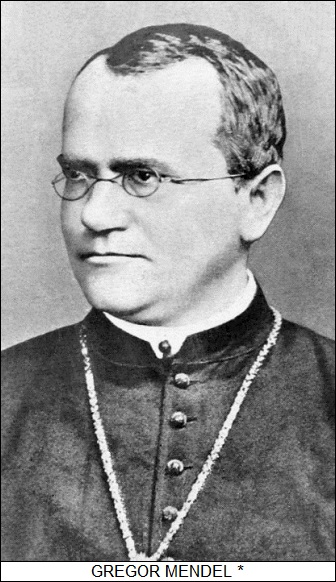
Mendel finally came up with seven true-breeding traits to tinker with, which took alternative forms, listed below in a slightly simplified way:
Mendel then started crossing the plants. The first observation that he made was that if plants with a specific opposed trait were crossed -- for example, one plant with round peas crossed with one plant with wrinkled peas -- then all the results of the first generation of the cross had the same single trait, with no mixing of traits. In this case, they would all have round peas. The same principle applied to all seven traits, with crosses yielding yellow pea interiors, or purple flowers, or puffed up seed pods -- but not green pea interiors, white flowers, or deflated seed pods.
Now Mendel crossed the results of each crossing among themselves, and found out something fascinating: the second generation did not breed true, and the way it didn't breed true was distinctive. Crossing the hybrid pea plants with round peas produced a second generation of pea plants, some with round peas and some with wrinkled peas. However, the ratio of the plants with round peas to those with wrinkled peas was a distinct 3:1. The same applied to the second generation of all the other hybrids. This was obviously not a pattern that resulted from chance.
Mendel concluded that the traits were encoded by what he called "factors", sometimes referred to as "Mendelian factors", but now called "genes" -- the usage preferred here even though Mendel never knew of it. For example, pea plants with round peas had a factor that could be labeled "R", while pea plants with wrinkled peas had a factor that could be labeled "W", with the two different or "polymorphic" forms of the gene being later called "alleles". How the genes were actually constructed, Mendel had no idea -- in fact, nobody would know for sure until the middle of the next century -- but he could infer their existence from how the plants bred.
Furthermore, he assumed that each plant had twin genes for the particular trait, and that each parent provided one gene each for that trait to its progeny -- the matching specific genes from each parent later being described as "homologous". The true-breeding plants with round peas had a gene pair "RR", while those with wrinkled peas has a gene pair "WW". Bred among themselves, the true-breeding plants with round peas would produce progeny with round peas since each parent would contribute an "R" gene and the result would be "RR". Similarly, breeding the pea plants among themselves would produce a generation with the gene pair "WW", and all the peas would be wrinkled. The matched gene pairs are now referred to as "homozygous".
However, if the two distinct lines were crossed, all the progeny would have the gene pair "RW" -- a mixed or hybrid gene pair, what is now referred to as "heterozygous". They would all produce round peas. What Mendel realized was that one gene overrode the other; as he put it, one was "dominant" and the other "recessive", terminology that is retained today. (The terminology is a bit unfortunate in that "recessive" seems to imply "inferior", which is not the case, but we're stuck with it now.) In this case, the gene for round peas was dominant, the gene for wrinkled peas recessive.
Matters became even more interesting when this hybrid generation was bred among itself, giving four possible results:
RR WR RW WW
In the last case, "WW", the recessive gene can be expressed and the result is wrinkled peas. That's why, on the average, the second generation had this clear 3:1 ratio of traits.
Mendel also recorded the effects of crosses on two traits. Given, say, a line of true-breeding plants with round peas and yellow (Y) pea interiors, and a line of true-breeding plants with wrinkled peas and green (G) interiors, then the first generation of the cross would all have the "genetic" coding of RWYG, giving round peas and yellow pea interiors -- yellow being dominant over green. Inbreeding that first generation would give the possibilities, along with the traits they produced:
__________________________________
RRYY = RY
RRYG = RY
RRGY = RY
RRGG = RG
RWYY = RY
RWYG = RY
RWGY = RY
RWGG = RG
WRYY = RY
WRYG = RY
WRGY = RY
WRGG = RG
WWYY = WY
WWYG = WY
WWGY = WY
WWGG = WG
___________________________________
9 RY 3 RG 3 WY 1 WG
___________________________________
The actual results reflected this 9:3:3:1 ratio. He completed his work in 1864 and published the results in 1866. It was all neatly done, in fact astoundingly neatly done, since as the previous history of heredity studies were full of confounding results, and Mendel had to have enormous insight to see through them to find out the facts.
The first issue was that, obviously, an organism had a lot of different genes, the sum of them being now called the "genotype", that resulted in a lot of different traits, the sum of them now being called the "phenotype". That's why the blending notion seemed so plausible, with the progeny of two parents obtaining a mix of the genes of the two. Mendel had to be shrewd to sort through the traits of pea plants to find a set that were distinct enough to permit methodical analysis. Worse, as Mendel understood, a specific trait of an organism might be determined by several genes, such traits now being known as "polygenic" -- and on the other side of the coin, some genes might each control several traits, such genes now being known as "pleiotropic".
In some ways, a pea plant was an unrepresentative test subject, because its heredity was unusually simple, but that was what made it useful to help sort through the noise to find the signal. Mendel was actually a physicist by training and, though he didn't have Darwin's sweep of vision, he far surpassed Darwin in rigor -- Darwin's own fiddlings with pea plants had been elementary in comparison, and Darwin himself admitted he didn't have a good head for quantitative analysis. Mendel's work, in comparison, was impressively rigorous, and in fact his results were so tidy that there were some who would later suspect that his figures had been fudged. However, the meticulous way the experiments were conducted and documented suggests simply that Mendel really was that good. The argument is academic anyway, reduced to irrelevance by the fact that all later experiments would show that Mendel's answer was absolutely on target, and claiming that was due to luck or cheating is immaterial.
* In fact, nobody raised any objections to his work at the time -- for the simple reason that nobody noticed it. In 1867, Mendel became the abbot of the monastery, meaning that he had to increasingly focus on administrative issues. He continued to perform studies on heredity, but not only did he have less time to spend on them, he also selected some poor test subjects. Under the encouragement of the Swiss botanist Carl Naegeli, then a prominent figure, Mendel investigated the hawkweed. It was a bad choice. Pea plants were good subjects since they could be inbred by self-fertilization, but hawkweeds have the confounding habit of "parthenogenesis" -- they could reproduce without being fertilized. Trying to figure out any pattern of inheritance with such a flexible organism was endlessly difficult, and went nowhere.
Mendel died in early 1884, a respected and influential local figure, but not one recognized by those who knew him personally as a great scientist. His obscurity remains a bit puzzling, since he was scientifically well-connected and his research was in hindsight brilliant. However, not having obtained any stature in his scientific work, during his lifetime the paper would not be read by anyone who grasped its real significance. Naegeli seemed particularly obtuse to the significance of Mendel's research, making the association between the two men a real disaster.
Mendel himself didn't seem to understand the significance of his work; he was apparently familiar to some greater or lesser degree with Darwin's writings -- given their scientific prominence at the time, it would actually be a bit surprising if he wasn't -- but never thought to send Darwin a copy of the paper on pea plant heredity. It was a belated tribute to Mendel's memory that the paper would, in less than two decades after his death, become recognized for the ground-breaking piece of work that it actually was.
BACK_TO_TOP* For all the weaknesses in Darwin's ideas at the time, he had still managed to obliterate for good the notion of fixity of species. By the early 1870s, there were few naturalists who didn't think he was on the right track, with the well-known American paleontologist Edward Drinker Cope (1840:1897) writing that the data accumulated in the wake of the publication of THE ORIGIN OF THE SPECIES had placed "the hypothesis on the basis of ascertained fact." The evolutionary faction in Britain was well-organized, even founding the science journal NATURE in 1869 in part to push evolutionary views. To this day, any publication in NATURE is prominently displayed in a researcher's resume.
Along with Huxley, there were other advocates for the evolutionary view. If Alfred Russel Wallace had been upstaged in the discovery of evolution by natural selection, he still remained very much a prophet for the idea, publishing a series of popular books, from the MALAY ARCHIPELAGO in 1869 to ISLAND LIFE in 1880, that reinforced Darwin's assertions about the distribution and variation of life-forms.
In Germany, the zoologist Ernst Haeckel (1834:1919) focused on studies of morphology -- the structures of organisms -- and in particular embryology to make a case for evolution. In his embryological studies, Haeckel showed the similarities between the embryos of different animals, and how these embryos had features at one time or another of ancestral species, such as rudimentary gill structures. Haeckel became one of the most high-profile advocates for evolutionary theory of his era.
However, although both Wallace and Haeckel supported evolution, they by no means whole-heartedly accepted Darwin's ideas. Wallace said that though he believed in evolution by natural selection, the development of the human consciousness demanded the efforts of an "Overruling Intelligence". It should be noted that Wallace was inclined to fringe ideas, including phrenology, spiritualism, and hostility to vaccines, which became more visible as he got older. Haeckel had strongly Lamarckian views, and he wasn't alone in this, not everyone being impressed by the idea of natural selection. Other biologists suggested an evolutionary scheme that became known as "orthogenesis", in which the evolutionary change of a species in a particular direction would acquire, for rationales not easy to grasp in hindsight, a sort of "momentum" driving it on to further change: start out with a wildcat, end up with a sabrecat.
In fact, in later editions of THE ORIGIN OF THE SPECIES, Darwin himself began to backtrack on his core concept of natural selection. The problem was that the prominent British physicist William Thompson, later Lord Kelvin (1824:1907), had calculated from the principles of physics known at the time that the Earth wasn't more than a few tens of millions or hundreds of millions years old. Huxley countered that geology suggested otherwise and that the calculations were based on faulty premises, but other physicists backed up the estimate. Huxley was right, but he couldn't prove the point at the time, and so the estimate stuck. Even the upper limit would have made the evolution of life by the process of natural selection implausible, and so Darwin kept adding more and more Larmackian tendencies to compensate.
Darwin had made evolution respectable, but his concepts for evolution by natural selection were increasingly scrambled by his own waffling and the proliferation of alternative ideas that incorporated Lamarckism or theistic concepts in various forms. His thinking also led to other lines of thought that would do much to taint his ideas over the coming century.
* As a footnote to this section, Haeckel is best remembered as the author of a lingering controversy. Haeckel's embryological studies followed up the work of a predecessor, Karl Ernst von Baer (1792:1876), the founder of modern embryology, who had noticed the emergence of vestigial gill structures and tails in the embryos of creatures that were born without such features, as well as the fact that in many cases the embryos of seemingly different animals were strikingly similar, suggesting that they were actually related.
Von Baer's insights are not now regarded as wrong, though they are seen as valid in some cases but not necessarily in others. They are useful clues, and Darwin made use of them in his brief. One intriguing example is that human fetuses have a coat of fine fur late in their development, which is lost before birth; the fur appears at much the same stage of development of monkeys, but it isn't lost. However, there are animals whose embryological forms are very different from one another but which are seen as clearly related from other evidence.
Haeckel took von Baer's ideas and claimed that the entire past history of an organism was reflected in its embryonic development, or "ontogeny recapitulates phylogeny". This is true in a broad sense, with ancestral embryonic features being demonstrated in development; but not true beyond that extent, certainly not to the extent that an embryo is a fully-developed fish and then a reptile and then a mammal. To make his case, Haeckel created sets of drawings of embryos that demonstrated their similarity, with the similarity exaggerated by fudging that the charitable describe as "sloppiness" but creationists label "fraud". The controversy, such as it is, lingers to this day -- but it amounts to nothing.
BACK_TO_TOP* One of Darwin's many correspondents was the English scholar Herbert Spencer (1820:1903), regarded by some as the first sociologist. Even before the publication of THE ORIGIN OF SPECIES, Spencer had been considering evolutionary ideas and their implications to human behavior and society. In 1855, he had published the groundbreaking PRINCIPLES OF PSYCHOLOGY, which postulated that the workings of the mind were rooted in the biology of the brain and body, a radical idea at the time.
Of course THE ORIGIN OF THE SPECIES buttressed his ideas, and in 1862 he published FIRST PRINCIPLES, in which he created a theory of evolution that covered social and ideological structures and not just the biology of organisms. In fact, it was Spencer who came up with the phrase "survival of the fittest", not Darwin, though Darwin would come to like it. Spencer's notion of applying evolutionary thought to society would prove popular, the main result being a doctrine known as "Social Darwinism", which would generally come to be thought of as an endorsement of remorseless capitalism and imperialism.
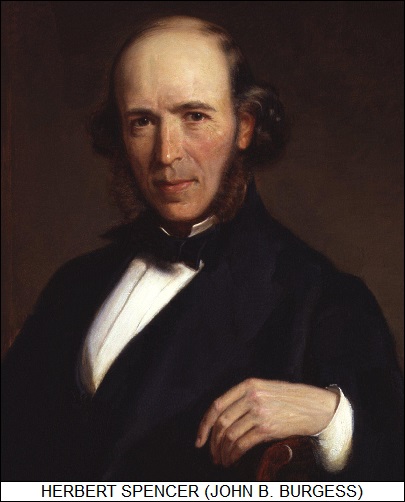
Spencer was no enthusiastic advocate of repressive social policies, but his coupling of a Victorian notion of evolution as a brutal struggle for survival to society easily inspired others to think in such a way. Darwin was not among such advocates; in fact, he was largely apolitical. He was not very impressed by Spencer's work, finding it lacking in substance and uninformed -- Spencer's evolutionary thinking was inclined to Lamarckism -- with Darwin writing in his autobiography:
QUOTE:
... I am not conscious of having profited in my own work by Spencer's writings. His deductive manner of treating every subject is wholly opposed to my frame of mind. His conclusions never convince me: and over and over again I have said to myself, after reading one of his discussions: "Here would be a fine subject for half-a-dozen years' work." His fundamental generalizations (which have been compared in importance by some persons with Newton's laws!), which I daresay may be very valuable under a philosophical point of view, are of such a nature that they do not seem to me to be of any strictly scientific use. They partake more of the nature of definitions than of laws of nature. They do not aid one in predicting what will happen in any particular case. Anyhow they have not been of any use to me.
END_QUOTE
These remarks were actually deleted by his son before publication, and were restored much later in an edition prepared by Darwin's granddaughter. Spencer's writings would not age well.
In any case, by the 1890s Social Darwinist ideas were popular and were making themselves felt, influencing social policies in the United States and elsewhere. Social Darwinism saw human society as based on a struggle for survival, in which the superior, the fittest, would triumph and the inferior would be swept to the wayside. It was more or less the ancient "predator ethic" -- the idea that might makes right, that the strong are entitled to oppress the weak -- dressed up in pseudoscientific clothes. If the struggle for survival was the way of the world, then it was only natural that human society should operate in the same way. Social Darwinism also dovetailed with racist thinking: American segregationists used the idea to promote the second-class status of black folk as a positive good. In Germany, Ernst Haeckel took the idea even farther, using it as a framework to propose Aryan race-supremacy notions and German militarism.
* Social Darwinism was not the only questionable doctrine to emerge from the ferment of evolutionary theory. A second path, "eugenics", was largely the creation of one of Darwin's cousins, Francis Galton (1822:1911), another grandson of Erasmus Darwin.
There was an undeniable streak of genius in Francis Galton. He learned to read at age two, aced his studies at Cambridge without trying, liked to tinker with inventions, and made scientific contributions to a wide range of fields, including meteorology and in particular statistical analysis. Even modern fingerprinting was invented by Galton. He was also a stereotype of the arrogant, self-superior upper-class Englishman. When the explorer Henry Stanley spoke to the British Association for the Advancement of Science in 1872, Galton pointedly questioned Stanley's parentage -- Stanley had been born illegitimate -- and sneered at Stanley's talk about his adventures in Africa, saying it was irrelevant to the deliberations of a scientific society. Stanley, it appears, was the kind of explorer who dealt with restless natives by shooting them; possibly it was fortunate for Galton that Stanley wasn't armed.
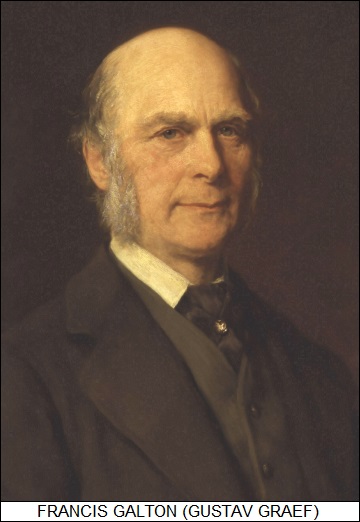
Galton's work on statistics largely focused on the characterization of various human traits, such as height, weight, strength, and so on, with the goal being the improvement of the race. In his 1869 book HEREDITARY GENIUS, he examined the genealogies and brilliant achievements of prominent families -- the descendants of Erasmus Darwin were a case in point -- and attributed them to a hereditary superiority. Since natural selection had managed to achieve such marvelous feats, Galton suggested that artificial selection could do even better. The obvious implication was to establish breeding programs to capitalize on successful lines of "breeding stock", a concept that he named "eugenics" -- from the Greek "well-born" -- in his 1883 book INQUIRIES INTO HUMAN FACULTY & DEVELOPMENT.
The idea of improving the human race sounds superficially appealing and not objectionable in itself, but it leads to two difficulties: first, determining what "improved" means; and second, figuring out how to get from here to there. Galton did his very best with his analyses to try to deal with the second problem, but as far as the first problem went, he didn't see it as an issue. It was obvious to him who the superior peoples were, and they were to be found among the white Europeans, not the inferior other human races of the Earth. It may not have been inevitable that eugenics would be a racist philosophy, but in practice they would be firmly associated.
It should be emphasized that Galton's focus was on breeding "superior" individuals, not on forcibly preventing "inferior" beings from breeding themselves. (Somewhat embarrassingly, his marriage was childless.) However, the issue of "inferior" individuals wasn't ignored elsewhere. In 1874, a New York sociologist named Richard Dugdale (1843:1881) performed an inspection of a jail in rural New York state and was surprised to find that six of the inmates there were related. He performed a genealogical study of the family, who he referred to as "the Jukes", going back five generations, to find out that fully half of the family were criminals, prostitutes, or impoverished. He published his findings in 1877 as THE JUKES: A STORY IN CRIME, PAUPERISM, DISEASE, & HEREDITY, with the book concluding that the degeneracy of the family was a hereditary condition.
The work of Galton and Dugdale created a bit of a public sensation, but at the time the matter was academic, with nobody seriously attempting to convert such ideas into laws. In those days, the upper classes generally bred among themselves anyway, and Galton's message simply suggested that what they were doing was along the right track. As far as the degenerate Jukes and their like went, the poor understanding of heredity of the time had the odd effect of canceling out the damning verdict of Dugdale's book. In the modern view, the degeneracy of the Jukes would not be attributed to any genetic fault, but to the impoverished and unhealthy environment in which the family existed. Dugdale had exactly the same view, phrased in Lamarckian terms: improve the environment of the Jukes and their heredity would improve as well. As Dugdale put it: "The correction is to change the environment." In time, attitudes would change for the worse.
BACK_TO_TOP